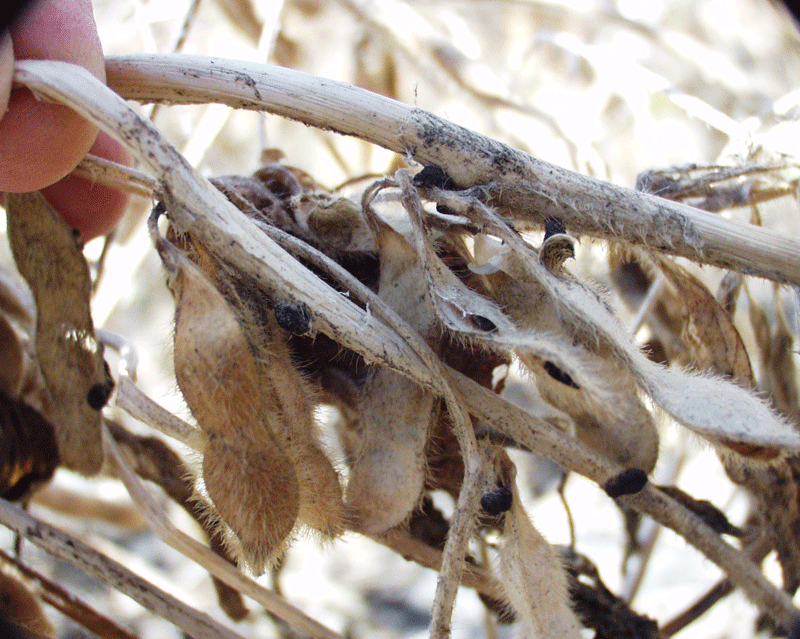The white mould problem
ANALYZING 2014’S YIELD ISSUES
WHITE MOULD IS among the many plant disease problems foisted on Ontario farmers in wet, cool years. In 2014, soybean producers experienced more than their share of the disease, cutting yields in some fields by 20 – 30 per cent. Problems weren’t confined to just one region in Ontario — in fact, crop specialists throughout the province reported white mould wherever wet, cool weather conditions prevailed, which was just about everywhere.

No wonder then it’s being called one of the worst outbreaks in the past 20 years, a “perfect storm” for white mould devastation, conservatively estimated to cause $20-$30 million in losses.
“Yield impact depends on how much of the field is affected, “says Dale Cowan, senior agronomist with AGRIS Co-op, Southern Cooperative Services. “But I saw one farmer getting 65 bushels to the acre in parts of the field where there was no white mould, and 22 bushels to the acre where there was.”
PERSISTENT PROBLEM
Unfortunately, the chances are very good white mould will rear its head again next year — or any year — if weather patterns repeat. That’s because once moisture-loving white mould takes hold in your fields, it’s there to stay. White mould, caused by the soilborne fungus Sclerotinia sclerotiorum, is extremely resilient and hardy. “Fields with white mould usually have a history of having the disease repeat,” says Cowan.
Most years, hot and dry summer weather helps control white mould by inhibiting the ability of the fungus to release spores and infect soybeans. But, when cool temperatures and rainy days persist, like they did this past spring and summer, the ideal conditions are created for the fungus to release spores and infect the crop. Spores get released from their mushroom-like hosts when soybeans are still in the early growth stages (around R1). They land on dying blossoms and petals that provide the initial energy source for the fungus to infect the rest of the plant. By the time you see the resulting wilting leaves and plants, it’s too late to do anything about it.
But all is not lost. Good management approaches can help minimize white mould damage by eliminating the conditions in which it thrives.
MANAGEMENT
First, try no-till. In the soil, white mould spores have a cozy place to survive. But on the soil surface, the elements assault them as they sit exposed. The spores will still have a good long life there — up to two to three years — but that’s brief compared to their lifespan of up to six to eight years in the soil itself if they get incorporated into it through tillage.
Crop rotation is another important management approach. Corn and wheat are not affected by white mould. So introducing those crops into an affected field eliminates hosts for spores, and breaks their reproduction cycle.
Some years, that’s hard advice to take. Field crop management specialists know it’s hard to resist planting back-to-back soybeans in years when prices are high. However, Albert Tenuta, field crop plant pathologist with the Ontario Ministry of Agriculture, Food and Rural Affairs, says you could be wasting money and resources.
“If the conditions are ripe for white mould again, the fungus will reduce soybean yields and potential profits that would have been made from back-to-back planting could be squandered anyway,” he says.
As well, your fields will be laden with even more of the fungus for the next time you grow soybeans there.
There has been an increase in fungicide availability as well as new biological control products which parasitize the sclerotia. This approach would be particularly attractive to organic growers, says Tenuta. In research plots at the University of Guelph Ridgetown Campus, soybeans are showing a modest yield gain in fields affected by white mould and other foliar diseases, compared to those planted without control products.
QUALITY YIELDS
Another line of defense against white mould is planting varieties that are tolerant or escape the disease and have less of a bushy architecture than others. White mould tolerance is an important trait which the University of Guelph breeding programs in Guelph and Ridgetown consider in germplasm development. That’s because white mould proliferates in damp places, such as under the dense canopy of soybean plants. Opening the canopy and managing the climate beneath it, by promoting air movement, will help reduce the chance of white mould taking hold.
“Create an environment that can dry out the ground under the canopy,” advises Cowan.
Yet another approach is to use variable rate seeding to reduce plant density in areas of your field where white mould has appeared. Using variable seeding to get the seeding rate down to around 120,000 seeds per acre in troubled spots will make the plants less dense in the field and help open the canopy, as will wider rows.
If you are shaking your head at the inherent irony of white mould management suggestions that reduce yield, you are not alone — Tenuta sees it too.
“Normally we try to help producers achieve higher yields,” he says. “We recommend narrow rows, early planting, good fertility, etc. But the things you do to increase your yield also increase your susceptibility to white mould. You need to scout your fields continually and know what you’re dealing with.”
RESEARCH INVESTMENT
White mould in soybeans is a complicated disease to control, requiring a suite of agronomic practices to keep it in check. One component of a management strategy is to choose less susceptible varieties as no variety is fully resistant.
Aiming to improve soybean resistance to white mould, Grain Farmers of Ontario jointly funded a white mould project with Agriculture and Agri-Food Canada (AAFC) which was led by Dr. Istvan Rajcan at the University of Guelph from 2010-2013. It focused on identifying what makes some soybean varieties more resistant to white mould than others. The project revealed that expression of certain genes was altered in partially resistant vs. susceptible varieties during infection — providing clues about candidate genes for resistance. Project results are now being incorporated into Rajcan’s soybean breeding program to help improve white mould resistance in new soybean varieties.
Rajcan’s soybean breeding program is currently part of the $10.3 million Canadian Field Crop Genetics Improvement Cluster funded by the Canadian Field Crop Research Alliance (CFCRA) and AAFC through the Growing Forward 2 AgriInnovation Program. Grain Farmers of Ontario is a founding member of the CFCRA. •

















